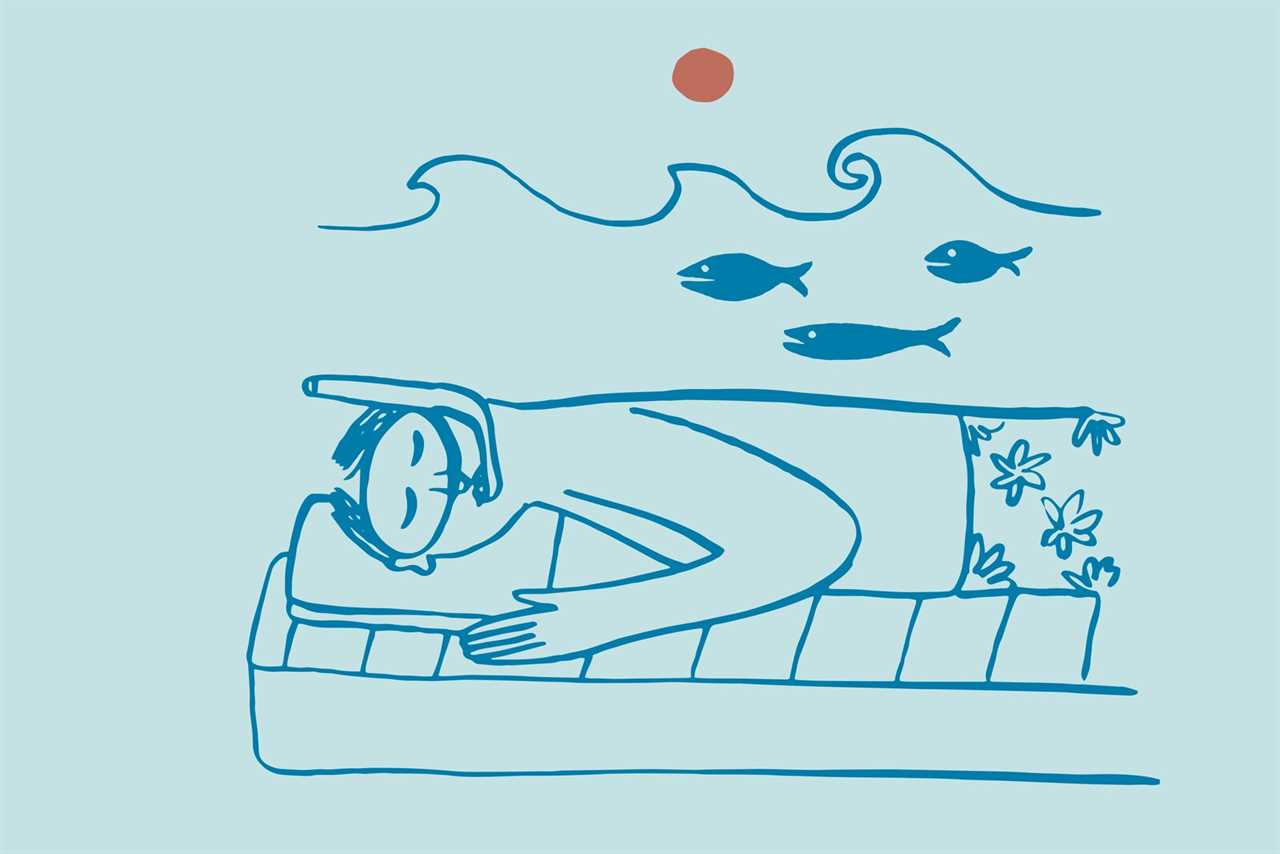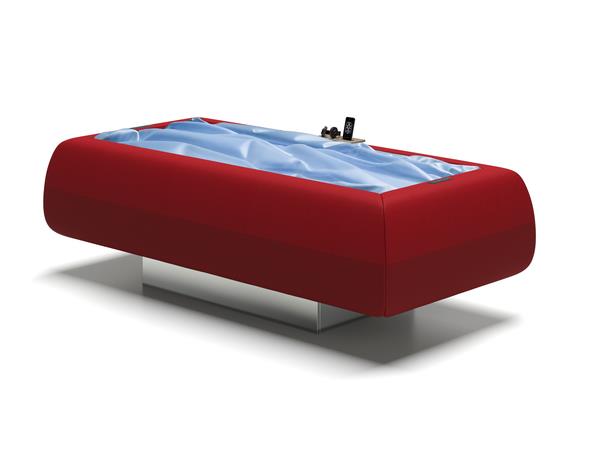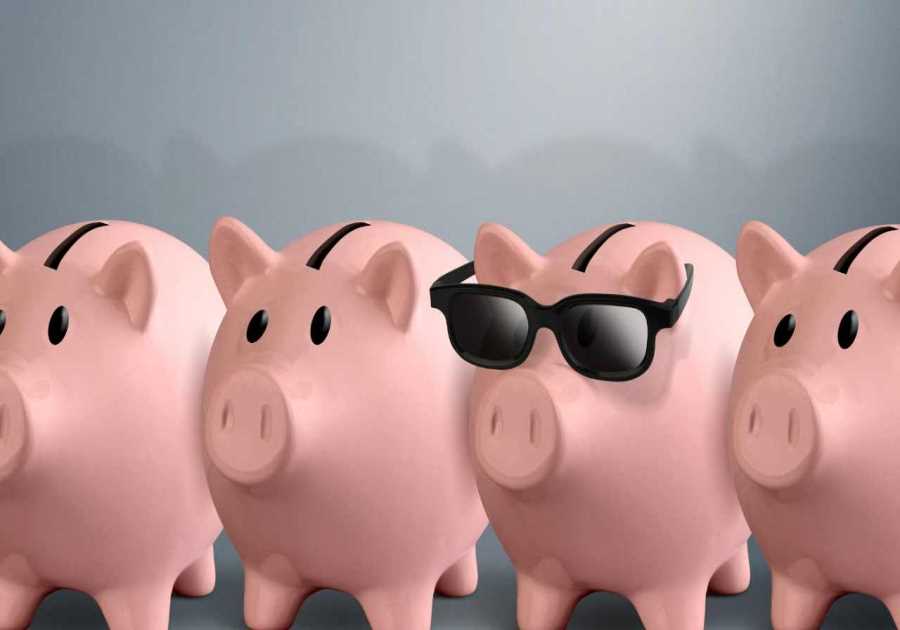Though it’s hardly the first time there’s been talk of a comeback, new sleep-focused consumer trends may be turning the tide.

It’s a few months back, and I’m settling into my uncle’s property on heritage Pennsylvania farmland to house-sit. Though the three-bedroom ranch house and newly built garage are decidedly modern, much else here seems stuck in time. The cornfield chapel in the distance. The restored cars from the ’60s parked down the road. And a waterbed—possibly the most controversial of all sleeping surfaces, besides a bed of nails—in the room where I’ll be sleeping. It’s a full-wave mattress (more on that later) corralled by a hulking antique wooden bed frame.
My boyfriend visits and we orbit around the waterbed like two planes trying to size up a graceful, or at least safe, landing. We try to read and talk on the fluid-filled mattress, but every time we move, it’s clumsy and loud. Waking up, however, I realize I slept much better than anticipated.
I feel like maybe I’ve underestimated the waterbed, and according to Lynn Hardman, the owner of Georgia’s oldest waterbed store, I definitely have— and I’m not alone. Hardman describes waterbeds as part of a "totally misunderstood category" of furniture, which seems to have been the case for a while now. The waterbed as we know it was invented in 1968 by Charles Hall, a San Francisco State University design student who presented the vinyl mattress filled with heated water as his master’s thesis project. Waterbeds quickly became a symbol of the sexual revolution—Hugh Hefner reportedly had a king-size waterbed covered in Tasmanian possum hair, and throughout the ’70s and much of the ’80s, many manufacturers marketed their waterbeds with suggestive nudges to its hedonistic associations. Even more innocent pop culture depictions of waterbeds often took a playful stance about the eccentric nature of the mattress. Still, within two decades, the waterbed transitioned from its Playboy bachelor pad phase to a full-fledged stint in the suburbs. By the peak of the craze in the late ’80s, more than one in five mattresses bought for American homes were waterbeds.
Since then, the waterbed has largely disappeared from American bedrooms, becoming more of a staple on Instagram nostalgia accounts and social media posts from people reminiscing about their existence (in varying levels of earnestness) or questioning where they’ve gone altogether. That might not be true for much longer, though: According to a November 2023 forecast from Verified Market Reports, an industry research and analysis consulting firm, the waterbed category is set to grow by nearly 10 percent by the end of 2030.
Some of what’s teeing up this projected revival might be explained by consumers’ embrace of the Wellness Era. GQ dubbed 2023 "the year of getting enough sleep," pointing toward trends like Andrew Huberman’s supplements concoction coined a "sleep cocktail" (not to be confused with TikTok’s "sleepy girl mocktail") and technologies like sleep tracking wearables including the Oura Ring. A Sleep Foundation survey found that Google searches for "sleep" reached an all-time high last year as well. Current generations are hell-bent on getting good sleep and reaping the resulting health benefits, with Gen Z leading the way (just head over to #sleeptok to find the bed people). Even the travel industry is adapting accordingly, from entire vacations dedicated to rest, complete with "sleep suites" that feature AI-assisted, smartphone-pairable mattresses, to hours-long sessions in sensory-deprivation chambers. The multibillion-dollar sleep tourism industry is booming.
Where the waterbed fits into all of this, though, it should be remembered: this isn’t the first time it’s been touted for a comeback since its rise and fall in popularity toward the end of the 20th century. In 2019, when the OG waterbed guy Charles Hall launched a new company touting a refreshed version of his original mattress design, some wondered whether a potential waterbed renaissance was brewing. A few years prior, Italian spa manufacturer Starpool debuted its Zerobody Dry Float system at Milan’s Salone del Mobile. The waterbed-like hydrotherapy device, developed in collaboration with Neocogita, a European firm specializing in wellness technologies, supposedly offers many of the same benefits as an immersion tank—positive impacts on sleep, stress, physical pain, and more—without the actual immersion, and is equipped with a touchscreen display and so-called "Brain Training" audio programs. It is, in essence, a waterbed, though not truly a mattress, more of a high-tech wellness product you’d find at a next-gen spa, hotel, or wellness center.

Italian spa manufacturer Starpool’s Zerobody Dry Float is technically a waterbed, though not truly a mattress—more of a high-tech wellness device you’d find at a next-gen spa.
Courtesy Starpool
In the waterbeds-you-can-actually-sleep-on (and afford) realm, more recent design innovations have had more to do with materials, breathability, and range of motion. Though early manufacturers added components like built-in heating and motion-reducing baffles (the latter leading to the creation of the hybrid category), many waterbed mattresses now have more personalizable features, like the ability to make one side of the bed warm while the other side is cool, or to change firmness and customize movement. For example, iZone™ by Boyd Flotation mattresses are divided into several "independent zones" on each side, meant to take pressure point relief to a whole new level. The hybrid mattresses incorporate a combination of water, air, and gel memory foam, and use mesh perimeters to enhance the beds’ breathability. Some other waterbed mattresses feature antibacterial bamboo fabrics that offset worries of unwanted microbe growth from skeptics hung up on the combination of wetness and warmth. "Temperature control is a big topic in sleep comfort today, whether it’s the bed, mattress protector, sheets, pillows, or even room temperature," says Hardman.
The full-wave, hardside mattress is typically what people think of when they hear "waterbed." It’s filled with fluid with a vinyl liner and requires a solid bed frame to stay in its shape. Apparently my family’s commitment to this traditional style runs deep, but Hardman says most buyers now opt for designs that limit motion and can maintain their shape without a solid bed frame—what’s called the softside mattress. "Several decades ago, it was predicted that 20 percent of waterbed sales would be made in softside beds and I remember thinking that would never happen," Hardman says. "But today softsides account for almost 100 percent of sales."
We’ll have to see out the decade to know whether the waterbed will actually have its comeback, and if so, in what form, but after almost 50 years in the bed business, Hardman says: "I still think the waterbed is the best bed that’s ever been invented." And they’re only getting more sophisticated.
Related Reading:
I Tried Three DTC Bed Companies to See If I Could Revamp My Sleep Life
Justice for the Single Bed
Read More
By: Samantha Leon
Title: Are We Heading for Another Attempted Waterbed Revival?
Sourced From: www.dwell.com/article/are-we-heading-for-another-attempted-waterbed-revival-9e809da8
Published Date: Mon, 13 May 2024 19:04:32 GMT
Did you miss our previous article...
https://trendinginbusiness.business/real-estate/uwms-agnes-standowicz-on-leadership-strategy-and-harnessing-technology
.png)





